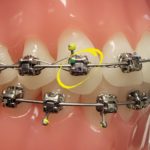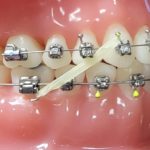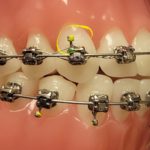First Visit
On your first visit, our amazing team will welcome you here, assisting with paperwork and any questions you may have. At this complimentary exam, you will discover your orthodontic needs, possible treatment options, and estimated fees.
Your new patient consultation will consist of the following:
- A tour of the office.
- A series of photographs of your mouth and teeth.
- A state-of-the-art 3D image.
- A comprehensive orthodontic evaluation where Dr. Buckman will present you with an individualized treatment plan for your new smile! Please remember that the consultation, including the photographs and 3-D image, are complimentary and our gift to you!
Financial
It is our mission to provide you with affordable, high-quality treatment that fits your budget! We feel confident that we can accommodate your needs. Some options available are:
- In house, interest free payment plan.
- Discount available for payment in full.
- Discount available for families with multiple patients.
- Most major credit cards accepted as well as Flex Cards with automatic drafting for your convenience.
Insurance
If your insurance covers orthodontic treatment, our goal is to maximize your benefits which will reduce your out of pocket costs. Out of network? No problem! Many insurance policies have a lifetime orthodontic benefit that is distinct from regular dental insurance. Typically, the same lifetime benefit applies both in and out of network. Remember that insurance policies vary, and we will confirm your insurance to determine benefits available. Buckman Orthodontics will file your claims directly with the insurance company.
FAQ’S
Is it required that my family dentist schedule my appointment with the orthodontist?
No, it is not. Many of our patients are referred by their family dentist, yet many other patients take the initiative to schedule an examination themselves.
At what age should I schedule an appointment for an orthodontic screening?
The American Association of Orthodontists recommends an orthodontic screening at age 7. By this age, several permanent teeth in most children have erupted allowing us to effectively evaluate their orthodontic condition.
Will my teeth straighten out as they grow?
No, they will not. The space available for the front teeth does not increase as you grow. In most people, after the permanent molars erupt, the space available for the front teeth decreases with age.
How do I schedule an appointment for an initial exam?
If you or your child can potentially benefit from orthodontic treatment, simply call our office or contact us directly to schedule an appointment.
What will happen at the initial examination appointment?
Upon arriving, each patient and parent will be seen by the staff and doctor who will acclimate you to our office and prepare you for the initial exam. We will take the necessary photographs and the doctor will then complete a brief, but thorough, exam.
To read more about your first visit, see our First Visit Page.
What will I learn from the initial examination?
There are five essential questions that we will cover during the initial examination:
· Is there an orthodontic problem and if so, what is it?
· What must be done to correct the problem?
· Will any teeth need to be removed?
· How long will the treatment take to complete?
· How much will the treatment cost?
Will I need to have teeth extracted for braces?
Removing teeth is sometimes required to achieve the best orthodontic result. Straight teeth and a balanced facial profile are the goal of orthodontics. However, because new technology has provided advanced orthodontic procedures, removing teeth is not always necessary for orthodontic treatment.
How long will it take to complete treatment?
Treatment time obviously depends on each patient’s specific orthodontic problem. In general, treatment times range from 12 to 30 months. The “average” time frame a person is in braces is approximately 22 months.
How much will braces cost? Are financing options available? How does my insurance work?
It is impossible to give an exact cost for treatment until we have examined you. We will cover the exact cost and financial options during the initial examination. We have many financing options available to accommodate your needs, and we will review these with you. We will also review your insurance policy, and help to maximize your benefit and file your claims.
How often will I have appointments?
Appointments are scheduled according to each patient’s needs. Most patients in braces will be seen every 5 to 10 weeks. If there are specific situations that require more frequent monitoring, we will schedule appointments accordingly.
Can I schedule all of my appointments after school?
Unfortunately, we cannot schedule all appointments for students during after-school hours. However, because most appointments are scheduled 5 to 10 weeks apart, most patients will miss minimal school due to their orthodontic treatments. We will, however, make a sincere effort to meet your scheduling needs.
Can I drop my child off for an appointment?
Yes. We understand your busy schedule, and we are happy to help you make the most of your time. On some occasions, we may request to speak with a parent when they return, so we ask that parents check in with the receptionist before dropping off their child.
Do braces hurt?
Generally, braces do not “hurt”. After certain visits, teeth may be sore for a few days. In these situations, pain medications such as Advil or Tylenol will ease the discomfort. However, after most visits, patients do not feel any soreness at all! We often remind our patients, “It does not have to hurt to work!”.
Can I return to school the day I receive my braces?
Yes. There is no reason to miss school because of an orthodontic appointment.
Do you give shots?
No. Shots are not necessary in orthodontic treatment.
Do you use recycled braces?
Absolutely not! It is our belief that each patient should be provided with their own braces to achieve the best orthodontic result possible.
Can I still play sports?
Yes. We recommend a mouth guard for all sports.
Do I need to see my family dentist while in braces?
Yes! Regular checkups with your family dentist are important while in braces. Your family dentist will determine the intervals between cleaning appointments while you are in braces.
Are there foods I cannot eat while I have braces?
Yes. Once treatment begins, we will explain the complete instructions and provide a comprehensive list of foods to avoid. Some of those foods include: ice, hard candy, raw vegetables and all sticky foods (i.e. caramel and taffy). You can avoid most emergency appointments to repair broken or damaged braces by carefully following our instructions.
How often should I brush my teeth while in braces?
Patients should brush their teeth at least 2 times each day: after breakfast and before going to bed. We will show each patient how to floss their teeth with braces, and may also provide a prescription for a special fluoride rinse if necessary.
What is an emergency appointment? How are those handled?
If your braces are causing extreme pain, or if something breaks, you should call our office. In most cases we can address these issues over the telephone. If you require an emergency appointment, we will set aside time for you.
Can orthodontic correction occur while a child has baby teeth?
Yes. Some orthodontic problems are significant enough to require early intervention. However, if a patient is not yet ready for treatment, we will follow that patient’s growth and development until the time is right for treatment to begin.
What is Phase One (early) Treatment?
Phase One treatment, if necessary, is usually initiated on children between the ages of 7 and 10. Phase One treatment lasts about 12-24 months. The primary objective for Phase One treatment is to address significant problems to prevent them from becoming more severe, and to improve self-esteem and self-image.
Will my child need full braces if he/she has Phase One treatment?
It is best to assume that your child will need full braces even after Phase One treatment. The period following Phase One treatment is called the “resting period,” during which growth and tooth eruption are closely monitored. Throughout this period, parents and patients will be kept informed of future treatment recommendations.
Will my child need an expander?
At the completion of the initial examination, we will determine whether a patient will need an expander.
Is it too late to have braces if I am already an adult?
A surprising percentage of our patients are adults. In fact, 25% of all orthodontic patients are adults. Health, happiness, and self-esteem are vitally important to adults. No patient is “too old” to wear braces!
Can I wear braces even though I have crowns and missing teeth?
Yes. A tooth with a crown will move just like a tooth with a simple filling. When teeth are missing, orthodontic treatment will aid in the alignment of the remaining teeth.
Why should you choose an orthodontic specialist?
Teeth, and sometimes entire facial structures, are permanently changed by orthodontic treatment. It is important that the treatment be appropriate and properly completed. Orthodontic specialists have extensive and specialized training that enables them to provide their patients with professional, personalized treatments.
Orthodontic Dictionary
Parts of Braces
Appliance
A device that assists in the straightening of teeth. Like braces, Invisalign, and retainers.
Bonding
The technique of attaching an orthodontic device directly to the enamel of the tooth with the use of adhesive.
Palatal Expander
A device used to widen the upper jaw so that the upper and lower teeth will fit together.
Retainer
A device, usually made of plastic and wires, to hold teeth in position after treatment.
Archwire
The metal wire that connects each bracket that is on each tooth in braces.
Forsus
A device used to improve the placement of the bite or jaw.
Clear Aligners
A type of treatment that uses a series of clear plastic aligners, similar to clear retainers, to gradually move teeth.
Separator
A device or instrument designed to wedge teeth apart, particularly teeth in tight contact. Frequently used for the examination of proximal surfaces, finishing a restoration or before banding.
Band
A metal device that wraps around the tooth to hold a bracket or tube in place.
Coil Spring
A spring that fits between the bracket and the archwire to open space between teeth.
Herbst Appliance
A device that corrects overbite by holding the lower jaw in a protrusive position.
Wax
A soft, malleable substance placed on brackets to prevent rubbing or irritation.
Bite Turbo
A small orthodontic device placed on the back of the upper front teeth to prevent full closure of the teeth. This protects the lower braces from being damaged by the bite.
Mouth Guard
A tooth or gum shield worn by patients (athletes) to prevent injuries.
Orthodontic Procedures
Debanding/Debonding
The process of removing orthodontic appliances from the teeth.
Bonding
The attachment of an orthodontic device directly to the tooth enamel.
Impression
A replica of teeth and oral tissue made from a thick liquid material that sets as a solid rubber mass.
Cephalometric X-ray
A diagnostic tool very similar to an X-ray. This device is typically used for treatment planning.
Panoramic X-ray
Wraparound photographs of teeth using an X-ray machine.







